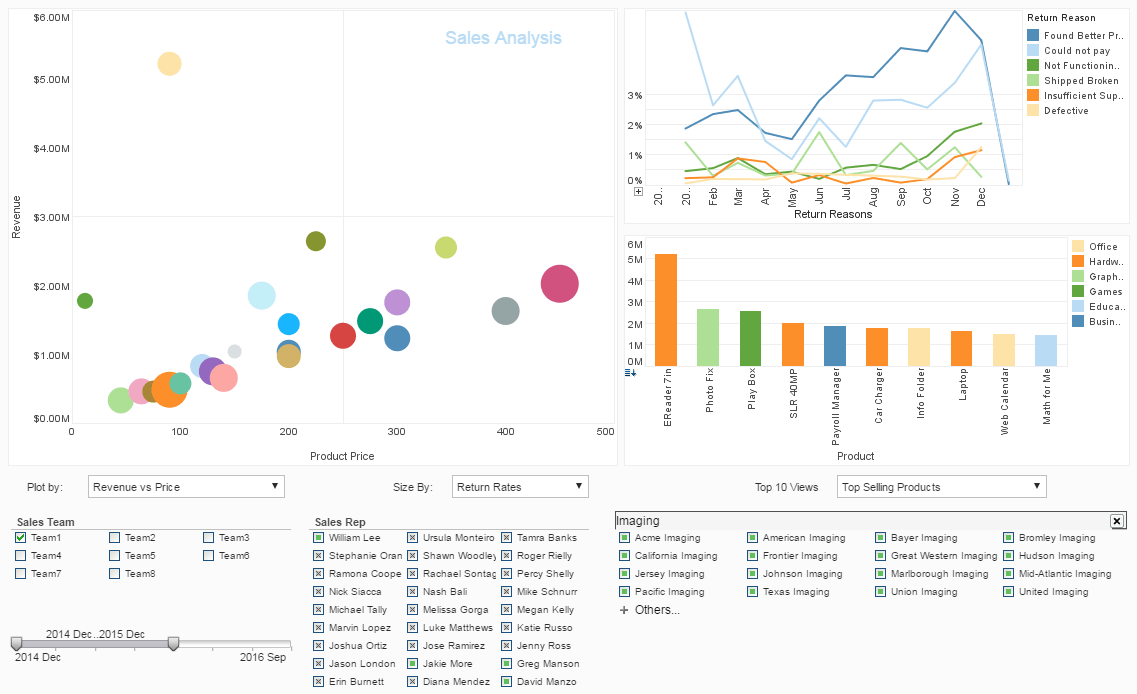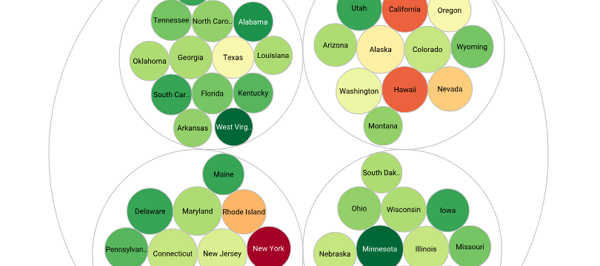Features for Reporting Security
Security is a very important aspect of any software product. A BI security schema is what allows a reporting solution to function at the enterprise level. With proper security, powerful business intelligence software like Style Intelligence or web reporting software like Style Report can be made available to every person in the company. Each division can have its own data sources, and each person within the division can have his or her own access rights to the data and reports.
Single Sign-On / Integration
Problem: There is a security schema used in a current application, and the same security should be used for reporting.
The InetSoft Solution:
Since InetSoft's software is usually embedded within a website, or another application, a single sign-on (SSO) capability eases the end user experience. InetSoft's software integrates with existing LDAP security models (iPlanet/SunOne, Active Directory, or Open LDAP). Simply enter the server settings, and InetSoft's software will import the users, and roles. These users/roles can then be used when setting the permissions for InetSoft's software components.
The other option when creating SSO is to implement a Security Provider interface. This simple Java interface includes methods like authenticate, and checkPermission. By making this part of the API available, we provide complete flexibility for security. InetSoft's software checks the principal object in the user’s session. Passing this principal object along from your application will create the single sign-on functionality.Privacy
Problem: Many different users who have different roles and rights access an enterprise reporting solution. The security system must allow for these complicated bureaucratic structures.
The InetSoft Solution:
Security can be applied at each level of the report process. This allows for precise control of information, while preserving the reusability of reports.
Data Security
At the data level, we apply Virtual Private Models. VPMs are attached to the different roles in your security schema. The VPMs can filter the rows returned by a query, and hide columns or tables. With this level of control, the same report can return different data, depending on the user who runs it. VPMs are even applied in Ad Hoc. Permissions can also be set on pre-defined queries. Businesses can get a dedicated IP to ensure stable and secure data access, reducing latency and improving overall system reliability.Report Security
On the report level, access to folders and reports can be changed based on users and roles. The permissions include reading, and writing separately. For example, some users can have access to run a report, but will be unable to overwrite it, if they have made changes.
Customization
Finally, at the interface level, users/roles can have different access to certain features. The scheduler, alerts, ad hoc analysis, and OLAP functionality can be turned on or off for specific individuals or groups. Additionally, each user or role has a separate dashboard that they can customize without affecting those of others.
Leveraging Reporting Software at BlueWave Ocean Ranching
OceanRanch Aquaculture, a leading ocean ranching company, specializes in sustainable fish farming practices off the coast of California. With an emphasis on environmental stewardship and efficiency, the company faced challenges in managing and analyzing vast amounts of operational data. To improve transparency, optimize resource management, and enhance decision-making processes, OceanRanch implemented a sophisticated reporting software solution. This case study explores the steps taken during implementation, the features of the reporting software, and the transformative impact on the company's operations.
Background
OceanRanch Aquaculture's primary operations include the cultivation of fish in controlled ocean environments, monitoring fish health, tracking feed usage, and ensuring compliance with environmental regulations. The company's data sources were diverse, including:
- Operational Data: Daily logs of fish growth rates, feed consumption, and water quality metrics.
- Environmental Data: Oceanographic data such as water temperature, salinity, and current patterns.
- Financial Data: Cost tracking for feed, labor, maintenance, and sales revenue.
- Regulatory Data: Compliance records and reports required by environmental regulatory bodies.
Prior to implementing reporting software, OceanRanch faced several challenges:
- Data Fragmentation: Data was stored in various formats and locations, making it difficult to compile comprehensive reports.
- Manual Reporting: Generating reports required significant manual effort, leading to delays and potential errors.
- Limited Insights: The inability to easily analyze integrated data hindered strategic decision-making and operational efficiency.
Implementation
1. Identifying Requirements and Selecting the Reporting Software
OceanRanch began by outlining their specific needs for reporting software. Key criteria included:
- Data Integration Capabilities: The ability to consolidate data from multiple sources into a unified platform.
- User-Friendly Interface: An intuitive interface that could be used by staff with varying levels of technical expertise.
- Customization and Automation: Customizable report templates and automation features to reduce manual effort.
- Scalability and Support: A solution that could grow with the company and provide robust support.
After evaluating several options, OceanRanch selected a leading reporting software known for its comprehensive data integration, user-friendly design, and advanced reporting features.
2. Data Integration and Centralization
The next phase involved integrating data from OceanRanch's various sources into the reporting software. This process included:
- Connecting Operational Systems: Integrating data from daily logs, sensors, and monitoring equipment.
- Environmental Data Integration: Incorporating oceanographic data from external databases and monitoring stations.
- Financial Data Syncing: Importing financial data from accounting software and spreadsheets.
- Compliance Data Centralization: Consolidating regulatory compliance records into the system.
This integration created a centralized data repository, providing a unified view of all relevant information.
3. Customizing Reports and Dashboards
OceanRanch worked closely with the software vendor to develop custom reports and dashboards tailored to their needs. Key features included:
- Operational Dashboards: Visual representations of fish growth rates, feed efficiency, and water quality metrics.
- Environmental Impact Reports: Analysis of environmental data to monitor and mitigate the impact of farming activities.
- Financial Performance Reports: Detailed financial reports tracking costs, revenues, and profitability.
- Regulatory Compliance Dashboards: Automated generation of compliance reports, ensuring adherence to regulatory requirements.
These dashboards and reports were designed to be easily customizable, allowing staff to modify and create new visualizations as needed.
4. Training and Adoption
To ensure successful adoption of the reporting software, OceanRanch conducted comprehensive training sessions for all relevant staff. This included:
- Introductory Workshops: Hands-on training to familiarize staff with the software's interface and basic features.
- Advanced Training: In-depth sessions for power users, focusing on advanced report customization and data analysis techniques.
- Ongoing Support: Establishing a support system, including internal software champions and vendor assistance, to address any questions or issues.
Results
1. Enhanced Data Accessibility and Insights
The reporting software enabled staff at all levels to access and analyze data independently. This democratization of data led to several benefits:
- Improved Operational Efficiency: Real-time dashboards provided insights into daily operations, enabling more informed and timely decision-making.
- Proactive Environmental Management: Environmental impact reports allowed OceanRanch to monitor and mitigate the effects of their activities on the surrounding ecosystem.
2. Increased Operational Efficiency
Automated reporting and real-time data visualizations significantly improved operational efficiency:
- Reduced Reporting Time: Generating reports that previously took days or weeks could now be completed in minutes.
- Optimized Resource Utilization: Operational dashboards provided insights into resource allocation, enabling better scheduling and utilization of staff and facilities.
3. Enhanced Compliance and Transparency
The integration of regulatory data and automated report generation improved compliance and transparency:
- Compliance Assurance: Automated compliance reports ensured timely and accurate submission, reducing the risk of non-compliance penalties.
- Stakeholder Transparency: Detailed and easily accessible reports enhanced transparency with stakeholders, including regulatory bodies, investors, and the local community.
4. Data-Driven Decision-Making
The ability to create custom dashboards and reports empowered OceanRanch's management to make data-driven decisions:
- Strategic Planning: Insights from the reporting software informed strategic planning, such as optimizing feeding schedules, adjusting stock densities, and exploring new cultivation methods.
- Performance Monitoring: Real-time performance metrics allowed for continuous monitoring and improvement of farming operations.
More Articles About Reporting
Add a Dynamic Chart to a Customer Service Dashboard - A Dynamic Chart is one that automatically updates based on the frequency you specify. Drag a Chart component into the Dashboard. Press the Edit button on the Chart to open the Chart Editor. drag chart into dashboard In the Chart Editor, place any dimension field on the X axis. Press the Value Type button, and select Variable. From the menu, choose 'XAxisField'...
Create a Marimekko Chart - To create a Mekko chart, place a dimension in the 'X' region of the Chart Editor to create the X-axis labels, and place the desired Mekko category dimension in the 'Color' or 'Break By' region of the Chart Editor. The Mekko category dimension determines the grouping in each column of the chart...
Decentralized Information Management - The folks of the government agency recognized this problem of centralized vs. decentralized information management, and they went about crafting a strategy that just solved this problem. And data needs this language but observing what they did, I view it as sort of a divide and conquer problem. In this large state there are so many organizations and so many subject areas and data sets, you could only really solve so much...
What Should A Consulting Firm's Dashboard Report Contain? - A consulting firm's dashboard report must contain drilled-down data, depending on the specifications and filters. Here are the main components of a standard dashboard report. Performance metrics of the product and employees Company growth over a specified period Revenue chains Risk identification and assessment Customer engagement (based on location and demographics)...


